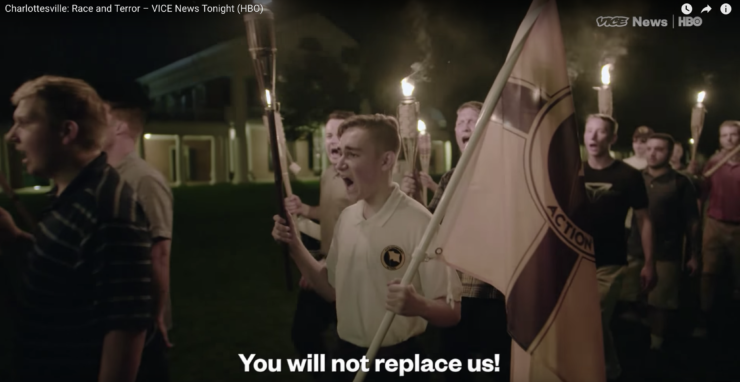
White supremacists rally in Charlottesville, Virginia in August, captured in Vice News Tonight's "Charlottesville: Race and Terror" documentary
A much-discussed Nazi-next-door piece in The New York Times went wrong for one reason: It treated the reporter’s discovery of the normalcy of white supremacy as news.
There is nothing new nor abnormal about white supremacy, just as there is nothing unusual about the bulk of white voters deciding to support a man despite his open bigotry. For much of our history, white men routinely used a distorted, criminal image of black people to win votes—and the hearts and minds of white people—and have long been rewarded for it. The election of 2016 was not an aberration; it was a continuation.
Repeat after me: White supremacy is American as apple pie. It has been a force at the center of our politics and this country’s social and religious norms since before its founding. It’s why men like George Washington and Thomas Jefferson could literally put their lives on the line in the cause of liberty and write that all men are created equal while owning and raping dark-skinned people.
It’s why slavery lasted about eight decades after this country became a democratic beacon of light. It’s why it took the bloodiest war in American history to end one form of slavery, only to have a compromise between white men in a hotly-contested presidential election to pave the way for a different form, which included public lynchings during which white families—including little white boys and little white girls—watched and sometimes cheered as black men and women were hung from trees or burned alive.
White supremacy has been so powerful and prevalent and long-lasting because it has always been the norm and largely propped up and supported by “normal” people, people who do the routine things William Anthony Hovater was described as doing in that New York Times piece. Normal people, including those who eventually out themselves as neo-Nazis and those who don’t, have always provided the energy for white supremacy. It’s not happenstance that an ungodly number of racial disparities exist in every industry and walk of life in a country that supposedly rewards merit and hard work like no other, and that white people, even poor white people, find themselves on the positive side of those divides.
That’s why countless attempts by countless journalists at countless publications desperate to understand why neo-Nazis feel emboldened by Donald Trump and why the majority of white voters supported him have simply glossed over this country’s racial history. The stories seem written as though America’s history did not exist. That’s why they could keep arguing the absurd: that what we are experiencing is the result of economic angst instead of the desperate flailing of a group of Americans who don’t want to see the country’s demographics continue diversifying. That’s the irony of the New York Times’ piece. It tried to center the most obvious form of white supremacy—calling it out specifically—but instead prioritized normalcy.
Until more journalists—and, let’s be frank, white journalists, given that journalists of color have made this point repeatedly—come to grips with that reality, we’ll continue having flameouts like that Times’ piece.
There will always be bright spots in our coverage of race, such as the well-received Vice documentary about what happened in Charlottesville. Why? Because we have extremely talented journalists from all backgrounds and races. Fortunately, that talent will often shine through. Unfortunately, because that talent sometimes helps journalists craft powerful pieces despite their refusal to take a deep dive into the complexity and nuance of our racial history and presence, it convinces too many of us that we don’t have to do any additional soul-searching about an issue too few journalists have spent enough time contemplating.
That’s why I’ll again make a plea to journalists I made months ago. Stop going into rural America looking for poor white people and struggling middle class people and grocery-shopping neo-Nazis to explain why our country is being led by a man who used open bigotry to fuel his ascent into the White House. Instead, spend that time questioning powerful white men and women who supported, and still support, President Trump despite all we know about him.
Ask Jerry Jones and the other owners of NFL teams who donated hundreds of thousands or millions of dollars to Trump’s campaign. Why do they seem more outraged by kneeling football players than they do by the bigotry those players are trying to highlight and combat? Ask Speaker of the House Paul Ryan why he defends Trump so frequently. Ask them why they were OK with his bigotry and what that says about their own beliefs and priorities. Without their support, Trump had no chance of winning, no matter how many poor white people from Appalachia attended his rallies.
That’s the only way white supremacy can sustain itself; it must be replenished by the powerful even as the powerless are scapegoated. That was the untold story of the 2016 presidential election cycle, and more than a year later, it is still untold.
They are the reason Trump is president, not a random neo-Nazi out of Ohio.
Tell that story.


